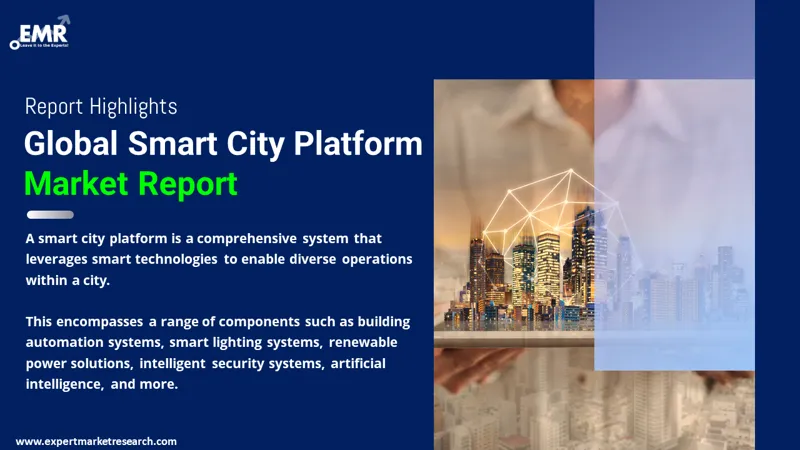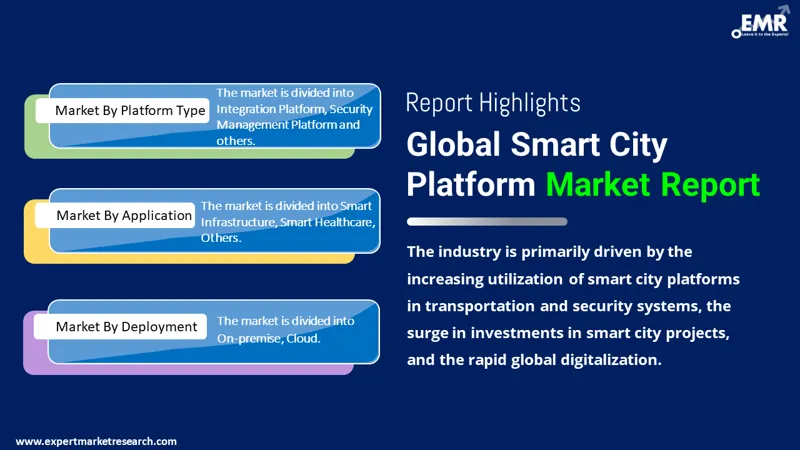
Consumer Insights
Uncover trends and behaviors shaping consumer choices today
Procurement Insights
Optimize your sourcing strategy with key market data
Industry Stats
Stay ahead with the latest trends and market analysis.
The global smart city platform market reached a value of approximately USD 50.15 Billion in 2025. The market is projected to grow at a CAGR of 49.20% between 2026 and 2035, reaching a value of around USD 2741.32 Billion by 2035.
Base Year
Historical Period
Forecast Period
The Ministry of Housing and Urban Affairs initiated the Smart Cities Mission (SCM) to develop 100 Smart Cities in India.
The Smart Cities Mission in India has been allotted Rs. 2,236 crores under the Interim Union Budget 2024–25, down from Rs. 7,535 crores in the FY24.
In 2023, Chinese government spending on smart city initiatives had reached USD 38.92 billion, as reported by the USCC.
Compound Annual Growth Rate
49.2%
Value in USD Billion
2026-2035
*this image is indicative*
The growth of smart city platform market is driven by factors such as rapid urbanization, increasing government initiatives for smart city development, advancements in IoT and AI technologies, rising demand for efficient urban infrastructure, and the need for sustainable solutions to address environmental challenges. Additionally, the integration of smart city platforms with various sectors such as transportation, energy management, healthcare, and public safety is further fuelling market expansion.
Smart city platform helps governments reach their beneficiaries and boost citizen engagement. In addition to this, the increasing adoption of smartphones, smart vehicles, tablets, and laptops has augmented the market growth. Furthermore, the increased demand for cloud-based models and the rising government expenditure to address pressing urban challenges and enhance security by embracing smart city agendas are likely to aid the smart city platform demand growth in the forecast period.

Read more about this report - REQUEST FREE SAMPLE COPY IN PDF
Artificial Intelligence (AI) and data analytics, energy management and sustainability, and smart infrastructure development are the major trends impacting smart city platform market value.
AI-driven analytics extract valuable insights from the vast amounts of data generated by smart city systems, significantly enhancing operational efficiency and optimizing a wide range of urban services.
Smart city platforms support energy-efficient practices, renewable energy integration, and environmental monitoring to enhance sustainability efforts, ultimately aiming to reduce the carbon footprint of urban environments, which will likely impact the smart city platform demand forecast.
Investments in smart infrastructure, including smart buildings, grids, and water management systems, significantly enhance urban resilience, improve safety, and elevate the overall quality of life for residents.
The deployment of 5G networks enables faster, more reliable connectivity, significantly supporting the growth of smart city applications and services, thus enhancing urban living standards and operational efficiency.
The growth of smart city platform market is fuelled by rising urban mobility challenges, prompting the adoption of intelligent transportation solutions like advanced traffic management and shared mobility services. Integration of public transit, ridesharing, bike-sharing, and micro-mobility solutions provides seamless, multimodal journeys for commuters and travellers.
Edge computing brings computational power closer to the data source, reducing latency, bandwidth usage, and response times for time-sensitive smart city applications. Edge computing architectures enable real-time data processing, analysis, and decision-making at the edge of the network, enhancing situational awareness, security, and responsiveness in urban environments.

Read more about this report - REQUEST FREE SAMPLE COPY IN PDF
“Global Smart City Platform Market Report and Forecast 2026-2035” offers a detailed analysis of the market based on the following segments:
Market Breakup by Platform Type
Market Breakup by Application
Market Breakup by Deployment
Market Breakup by Region
Security management platform boosts the smart city platform market revenue by facilitating rapid incident response via providing automated incident detection, notification, and remediation capabilities, minimizing the impact of security incidents on smart city operations.
The security management platform promotes cybersecurity awareness and provides training resources to smart city stakeholders, empowering them to recognize and mitigate security risks effectively.
By streamlining connectivity management processes and optimizing resource usage, the platform helps reduce operational costs associated with maintaining and managing smart city networks.
Smart healthcare platform enables real-time monitoring of patients' health metrics remotely, allowing healthcare providers to deliver personalized care outside traditional healthcare settings.
One of the key trends of smart city platform market is that smart city platforms facilitate the secure exchange of electronic health records (EHRs) and other health information among healthcare providers, improving care coordination and continuity across different healthcare settings.
Smart city platforms facilitate the integration of various transportation modes, including public transit, ridesharing, bike-sharing, and micro-mobility services, into a seamless and interconnected transport network. This improves mobility options for residents and reduces reliance on private cars.
The global smart city platform market is experiencing a surge, with two regions vying for the top spot. While North America currently boasts the largest smart city platform market share due to its established economies and strong technological foundation, Asia Pacific is projected to witness the fastest growth. This rapid rise in the Asia Pacific region is driven by factors like large-scale urbanization, increasing digitization efforts, and significant government investments in smart city initiatives, particularly in countries like China and Japan.
Europe's commitment to sustainability, government support, and strong technological base are not only propelling the market within the region but also influencing its growth globally.
The companies are a provider of products including data management, storage platforms, smart devices, industrial technology, and others.
Founded in 1910 and based in Santa Clara, California, the company offers a wide range of products, including storage platforms, data management solutions, and integrated systems for diverse applications.
Established in 1987 and based in Shenzhen, Guangdong. The company works as a leading global provider of information and communications technology (ICT) infrastructure and smart devices.
Founded in 1836 and based in Rueil Malmaison, Paris. The company is a worldwide leader in industrial technology, offering unparalleled expertise in electrification, automation, and digitization.
Founded in 1847 and based in Munich, Germany, the company is dedicated to technology, focusing on advancements in industry, infrastructure, transportation, and healthcare sectors to drive innovation and efficiency.
*Please note that this is only a partial list; the complete list of key players is available in the full report. Additionally, the list of key players can be customized to better suit your needs.*
Other global smart city platform market key players are Cisco Systems, Inc., and IBM Corporation, among others.




*While we strive to always give you current and accurate information, the numbers depicted on the website are indicative and may differ from the actual numbers in the main report. At Expert Market Research, we aim to bring you the latest insights and trends in the market. Using our analyses and forecasts, stakeholders can understand the market dynamics, navigate challenges, and capitalize on opportunities to make data-driven strategic decisions.*
Get in touch with us for a customized solution tailored to your unique requirements and save upto 35%!
The smart city platform market was valued at USD 50.15 Billion in 2025.
The smart city platform market is projected to grow at a CAGR of 49.20% between 2026 and 2035.
The revenue generated from the smart city platform market is expected to reach USD 2741.32 Billion in 2035.
The market is broken down into North America, Europe, Asia Pacific, Latin America, and Middle East and Africa.
The major industry drivers include the rising application of smart city platform in transportation and security systems, increasing investments in smart city projects, and the rapid digitalisation around the world.
The key market trends guiding the growth of the industry include the technological advancements in cloud-based e-governance software, including the addition of the latest features and the upgradation of existing models.
The market is categorised according to the platform type, which includes connectivity management platform, integration platform, device management platform, data management platform, and security management platform.
Based on the application, the market is divided into smart mobility/transportation, smart security, smart utilities, smart governance, smart infrastructure, smart healthcare, and others.
Based on the deployment, the market is divided into on-premises and cloud.
The key players are Hitachi Vantara LLC, Huawei Technologies Co., Ltd., Schneider Electric SE, Siemens Aktiengesellschaft, Cisco Systems, Inc., and IBM Corporation, among others.
Explore our key highlights of the report and gain a concise overview of key findings, trends, and actionable insights that will empower your strategic decisions.
| REPORT FEATURES | DETAILS |
| Base Year | 2025 |
| Historical Period | 2019-2025 |
| Forecast Period | 2026-2035 |
| Scope of the Report |
Historical and Forecast Trends, Industry Drivers and Constraints, Historical and Forecast Market Analysis by Segment:
|
| Breakup by Platform Type |
|
| Breakup by Application |
|
| Breakup by Deployment |
|
| Breakup by Region |
|
| Market Dynamics |
|
| Competitive Landscape |
|
| Companies Covered |
|
| Report Price and Purchase Option | Explore our purchase options that are best suited to your resources and industry needs. |
| Delivery Format | Delivered as an attached PDF and Excel through email, with an option of receiving an editable PPT, according to the purchase option. |
Datasheet
One User
USD 2,499
USD 2,249
tax inclusive*
Single User License
One User
USD 3,999
USD 3,599
tax inclusive*
Five User License
Five User
USD 4,999
USD 4,249
tax inclusive*
Corporate License
Unlimited Users
USD 5,999
USD 5,099
tax inclusive*
*Please note that the prices mentioned below are starting prices for each bundle type. Kindly contact our team for further details.*
Flash Bundle
Small Business Bundle
Growth Bundle
Enterprise Bundle
*Please note that the prices mentioned below are starting prices for each bundle type. Kindly contact our team for further details.*
Flash Bundle
Number of Reports: 3
20%
tax inclusive*
Small Business Bundle
Number of Reports: 5
25%
tax inclusive*
Growth Bundle
Number of Reports: 8
30%
tax inclusive*
Enterprise Bundle
Number of Reports: 10
35%
tax inclusive*
How To Order

Select License Type
Choose the right license for your needs and access rights.

Click on ‘Buy Now’
Add the report to your cart with one click and proceed to register.

Select Mode of Payment
Choose a payment option for a secure checkout. You will be redirected accordingly.
Gain insights to stay ahead and seize opportunities.

Get insights & trends for a competitive edge.

Track prices with detailed trend reports.

Analyse trade data for supply chain insights.

Leverage cost reports for smart savings

Enhance supply chain with partnerships.

Connect For More Information
Our expert team of analysts will offer full support and resolve any queries regarding the report, before and after the purchase.
Our expert team of analysts will offer full support and resolve any queries regarding the report, before and after the purchase.
We employ meticulous research methods, blending advanced analytics and expert insights to deliver accurate, actionable industry intelligence, staying ahead of competitors.
Our skilled analysts offer unparalleled competitive advantage with detailed insights on current and emerging markets, ensuring your strategic edge.
We offer an in-depth yet simplified presentation of industry insights and analysis to meet your specific requirements effectively.
Share